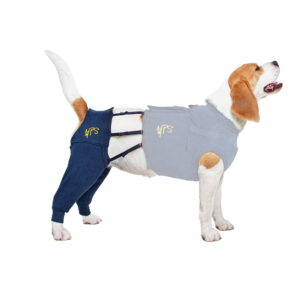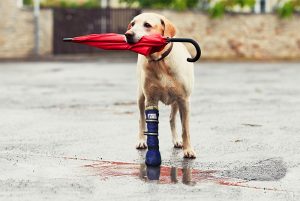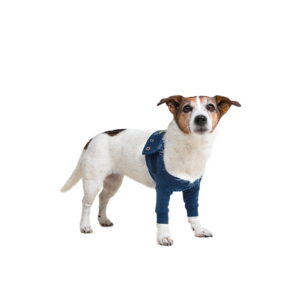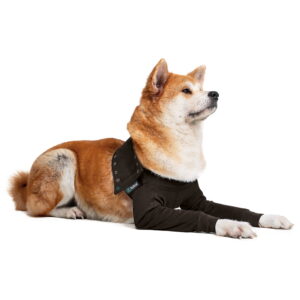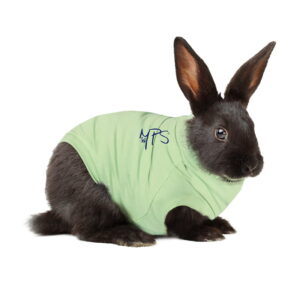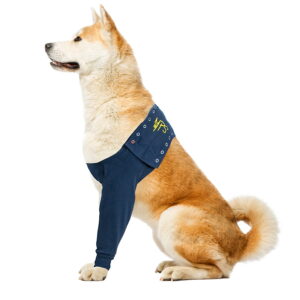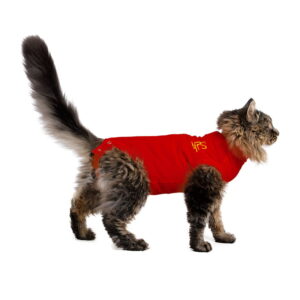The Cone of Shame: Better, Vet-Recommended Alternatives for Dogs and Cats
Also called: Elizabethan collar (E-collar), buster collar, lampshade collar.
Why recovery suits beat plastic cones
- Pets can eat, drink, sleep, and move more naturally while wounds stay covered.
- Lower stress and anxiety than rigid cones (2020 Animals journal study reported 77% of pets had negative effects with E-collars).
- Reusable and washable; a sustainable alternative to single-use plastic cones.
- Options for dogs and cats after spay/neuter, skin conditions, hotspots, and more.
- Easy bathroom access with built-in features; sizes for kittens to giant breeds.
—
What we mean by the “cone of shame”
For decades, the Elizabethan collar—often called the E-collar, buster collar, or “cone of shame”—has been the default tool to stop pets licking or chewing stitches and wounds. It works by physically blocking access. But pet care has moved on. We now have kinder, behaviorally smart options that protect healing skin without the stress and daily hurdles of a rigid cone.
The problem with traditional plastic cones (E-collars)
1) Physical discomfort
- Restricts movement and natural posture, may cause neck chafing.
- Makes everyday life harder: eating, drinking, sleeping, walking through doorways, getting in the car.
2) Psychological and emotional stress
- Cones block a pet’s field of vision and tactile input. That alone can increase anxiety.
- You may see panting, whining, pacing (dogs) or hiding, vocalizing, and reduced appetite (cats).
3) Behavioral impact and non-compliance
- If your pet won’t eat or keeps fighting the cone, recovery gets longer and more expensive.
- In a 2020 peer-reviewed Animals journal study, 77% of owners reported negative effects from E-collars, including quality-of-life and behavior issues.
—
Why vets recommend recovery suits over cones
Recovery suits and shirts are soft, form-fitting garments that create a protective barrier over surgical sites, hotspots, or dermatology flare-ups.
What makes them different:
- Comfort first: Breathable, stretchy fabric acts like a second skin.
- Freedom to be a pet: Normal posture, better sleep, easier eating and drinking, and safer navigation around the house.
- Coverage where it counts: Abdomen/flank surgeries, spay wounds, hotspots, and dermatitis patches are well protected.
- Reusable and washable: Good for multi-week recoveries or repeated skin issues.
TailMe tip: Many Fear Free-aligned veterinarians now reach for recovery garments first because pets stay calmer—and calm pets heal better.
—
Recovery suit vs inflatable collar vs cone
Different tools shine in different scenarios. Here’s a quick, practical comparison.
Comfort and mobility
- Plastic cone: Bulky; bumps into furniture and door frames; can alter posture.
- Inflatable collar: More comfortable than a cone but doesn’t cover wounds; flexible pets may still reach the area.
- Recovery suit: Full mobility with targeted coverage over the actual wound.
Eating and drinking
- Plastic cone: Bowls often need height or angle changes; many pets refuse to eat.
- Inflatable collar: Easier than a cone; still awkward for some brachycephalic breeds.
- Recovery suit: No interference with bowls; most pets eat and drink normally.
Sleeping, crate time, and stairs
- Plastic cone: Disturbs sleep and crate comfort; tricky on stairs.
- Inflatable collar: Better sleep; may still scratch at sites.
- Recovery suit: Usually sleep-friendly and crate-safe when fitted correctly.
Multi-pet homes
- Plastic cone: Can trigger collisions or scuffles; startles other pets.
- Inflatable collar: Lower startle risk; still doesn’t stop determined licking.
- Recovery suit: Low-profile protection with minimal disruption in shared spaces.
Protection
- Plastic cone: Visual and physical block; doesn’t protect the wound if rubbed on surfaces.
- Inflatable collar: Limits neck movement; no direct wound coverage.
- Recovery suit: Direct, full-coverage barrier over sutures and lesions.
Best for
- Plastic cone: Face/paw/ear surgeries where clothing can’t cover the site; very determined lickers.
- Inflatable collar: Mild cases or as an add-on to a suit for extra deterrence.
- Recovery suit: Spay/neuter, abdominal or flank surgeries, TPLO incisions (with supervision), hotspots, dermatitis.
—
Best alternatives after spay/neuter (dog and cat)
If you’re searching “how to stop my dog from licking stitches without a cone” or “e-collar alternative for cats after spay,” here’s the short version:
Dogs
- After spay (female): A recovery suit covering the abdomen keeps sutures clean and inaccessible. Typical wear time: 10–14 days; follow your vet’s timeline.
- After neuter (male): Many suits include a snap-back or tie-back potty panel. Check fit around the prepuce and scrotum. Inflatable collars can help for some males but don’t protect scrotal licking in flexible or small breeds.
- TPLO and other orthopedic surgeries: A recovery suit can prevent licking at the incision. Always follow your vet’s exercise restrictions and monitor for chewing near bandages.
Cats
- After spay: A cat-specific recovery suit keeps the abdomen covered without blocking whiskers or peripheral vision. Cats usually move, eat, and use the litter box more reliably in a suit than in a cone.
- After neuter: Many vets allow minimal protection; a light suit or inflatable collar may be enough. Follow clinic advice on your cat’s temperament.
High-intent questions we hear (and quick answers)
- My dog won’t eat with a cone—what can I use instead? A well-fitted recovery suit removes bowl barriers so most dogs resume eating within a day.
- Cat won’t use the litter box with a cone—help? Cat recovery suits keep whiskers free and vision clear; most cats use the box normally again.
Always confirm with your vet: When to start the suit, how long to wear it, and when to check the incision.
—
How to size and fit a recovery suit
A great fit is everything. Here’s a mini guide you can do at home in two minutes.
Measure
- Length: From the base of the neck (where a collar sits) to the base of the tail.
- Chest girth: Around the widest part of the ribcage.
- Neck: Around where a flat collar would rest.
- Weight: Helpful for tie-breaking between sizes.
Fit checks
- Snug but not tight: You should fit two fingers under the fabric.
- Shoulder mobility: Your pet should walk and sit without restriction.
- Bathroom access: Use the built-in potty panel or snap-back features as designed.
- Duplicate rotation: If surgery care lasts more than a week, consider two suits so one can wash while the other is worn.
Breed-specific tips
- Broad-chested (Frenchies, Staffies): Chest girth matters most—don’t size just by weight.
- Long-backed (Dachshunds): Prioritize body length so the abdomen stays covered.
- Giant breeds and kittens: Choose brands with extended size ranges.
Need help choosing? Find My Size or chat to our team—we’ll guide you to the right model and size.
Care and washing
- Machine wash cold, gentle cycle; air dry to protect elasticity.
- Fasten all snaps/Velcro before washing.
- Keep one clean spare on hand during the first week.
—
When a cone is still necessary
- Face, ear, or paw procedures where clothing can’t cover the site.
- Extremely determined lickers/chewers (a short cone or inflatable may be layered with a suit).
- Short, emergency situations when a universal, immediate barrier is needed.
Your vet will advise what’s safest for your pet’s specific procedure.
—
Quick picks
Comfort-first bestsellers our customers and vets love:
- Suitical Recovery Suit — Dog
– Full-body coverage with easy potty access. – Washable, reusable fabric designed for post-op care. – Ideal for spay, abdominal wounds, dermatitis. – [Shop now]
- Suitical Recovery Suit — Cat
– Cat-specific cut for whisker and shoulder comfort. – Great for spay and belly wounds; litter-box friendly. – [Shop now]
- MPS Medical Pet Shirt (Vet Range) — Dog
– Vet-trusted construction for clinics and home recovery. – [Shop now]
- MPS Hind Leg Sleeves — Dog
– Targeted protection for hind-leg hotspots or wounds. – [Shop now]
—
FAQs: Recovery suits for dogs and cats
Do recovery suits work for cats?
- Yes. Cats often tolerate suits better than cones because their whiskers and vision remain unobstructed, making eating and litter use more normal.
Can dogs sleep in recovery suits?
- Absolutely—most sleep better in a suit than in a cone. Ensure a snug, non-tight fit and check the incision twice daily.
How long should a dog wear a recovery suit after spay?
- Commonly 10–14 days, or until your vet clears you. Keep it on 24/7 except for brief checks and laundering; use a spare for rotation.
Can I use a baby onesie instead of a recovery suit?
- We don’t recommend it. Baby clothing isn’t designed for canine/feline anatomy, can rub sutures, and often lacks secure potty access. Purpose-built suits are safer.
Recovery suit vs inflatable collar—which is better?
- For abdominal or flank wounds, a suit provides direct coverage. Inflatable collars can help for some neuters or as an extra deterrent with a suit.
How do I wash and care for a recovery suit?
- Close all fasteners; machine wash cold, gentle cycle; air dry. Keep a second suit for hygiene during multi-day recoveries.
Is a recovery suit safe after TPLO?
- Many vets approve suits to prevent incision licking, but always follow activity restrictions and your surgeon’s guidance.
My dog keeps taking off the cone—what now?
- Try a recovery suit. If your dog is extremely determined, combine a suit with a soft short-cone or inflatable collar temporarily.
—
Evidence and vet guidance
- Research: “The Welfare Implications of the Use of E-Collars on Dogs and Cats,” Animals (2020). Finding: 77% of pets experienced negative effects from E-collar use, including reduced quality of life.
- Fear Free approach: Minimizing stress during recovery supports better outcomes and compliance. Recovery garments are a calm, welfare-led alternative.
Talk to your vet about your pet’s specific surgery, temperament, and environment. We’re happy to collaborate with your clinic on sizing and model choice.
—
Sustainability matters
Recovery suits are washable and reusable—far less wasteful than multiple single-use plastic cones. Better for your pet, kinder to the planet.
—
Real-life results from TailMe customers
- “Our Staffie wouldn’t eat with the cone. In the Suitical, she finished her dinner the same night and slept through.” — Megan D.
- “Post-spay for our cat: no cone drama, no litter issues, zero licking.” — Kabelo N.
Shipping, returns, and support
- Fast delivery and easy exchanges if the size isn’t quite right.
- Friendly, vet-savvy support to help you fit and use your suit correctly.
At TailMe, recovery shouldn’t feel like punishment—it should feel like care in every stitch.
—

